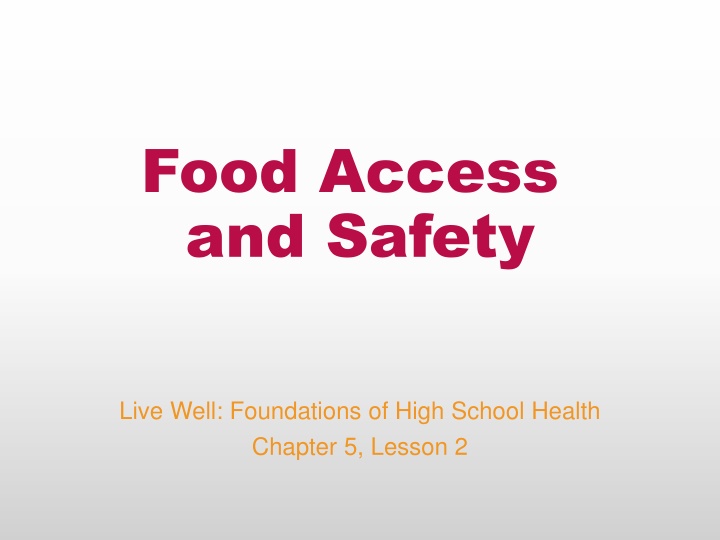
Understanding Food Access, Safety, and Influences on Nutrition
Explore the impact of location on food supply, the challenges of maintaining a healthy diet due to social and environmental factors, influences on food insecurity, the food chain and contamination sources, the four steps to food safety, and advocating for food access and safety.
Download Presentation

Please find below an Image/Link to download the presentation.
The content on the website is provided AS IS for your information and personal use only. It may not be sold, licensed, or shared on other websites without obtaining consent from the author. If you encounter any issues during the download, it is possible that the publisher has removed the file from their server.
You are allowed to download the files provided on this website for personal or commercial use, subject to the condition that they are used lawfully. All files are the property of their respective owners.
The content on the website is provided AS IS for your information and personal use only. It may not be sold, licensed, or shared on other websites without obtaining consent from the author.
E N D
Presentation Transcript
Food Access and Safety Live Well: Foundations of High School Health Chapter 5, Lesson 2
Write About It How does the location of where a person lives influence food supply? What social and environmental factors make it more challenging to eat a healthy diet?
Can you . . . Explain influences on food insecurity? Describe the food chain and identify ways that foods become contaminated? Explain the four steps to food safety? Practice advocating for food access and food safety?
Does Everyone Have Access to Enough Food? It is estimated that about one in every eight people in the United States is food insecure. Food insecurity refers to not having enough food to support an active, healthy life. People may be food insecure because they don t have enough money, can t get food supplies because they lack transportation, or can t move independently and must depend on others.
Free Breakfast and Lunch Programs Someone who is food insecure is likely to suffer from malnutrition, which is inadequate or unbalanced nutrition. Free breakfast and lunch programs in schools help fight food insecurity in many communities. For some students, a meal at school is the only balanced, hot meal they have all day.
Food Safety Even when you do have access to food, it isn t always safe to eat. Food can carry pathogens that cause foodborne illnesses. Food goes through several steps before it gets to your plate. These steps are called the food chain. Production, processing, distribution, and preparation of food
Safe Food Handling and Preparation (1 of 3) How you handle and prepare your foods will affect how likely they are to become contaminated. The most important thing you can do when handling and preparing food is to follow the four steps to food safety. 1. Clean 2. Separate 3. Cook 4. Chill (continued)
Safe Food Handling and Preparation (2 of 3) 1. Clean Clean your hands. Clean all utensils, cutting boards, and surfaces. Wash fruits and vegetables. Clean all surfaces thoroughly when finished prepping food. 2. Separate Separate produce from meats, eggs, and poultry. Use separate cutting boards for meat, eggs, and poultry. (continued)
Safe Food Handling and Preparation (3 of 3) 3. Cook Cook foods to the proper temperature to kill known pathogens. Serve food immediately, or make sure to keep cooked foods above 140 Fahrenheit if not being eaten right away. 4. Chill As soon as you are done eating, place all leftover foods in the refrigerator. Foods that require refrigeration should not be left out at room temperature for more than two hours to decrease the risk of bacteria growth.
Food Additives and Preservatives Food additives are substances added to food to improve freshness; add nutrition; and improve taste, texture, or appearance Additives that are designed to keep food from spoiling are called preservatives. Some preservatives contain chemicals like nitrates, nitrites, and sulfites, which may be dangerous to your health.
Pesticides and Organic Foods Pesticides are chemicals used to protect a crop from insects, weeds, and infections. Some foods are more likely to absorb chemicals than others. Organic foods are grown without chemical pesticides and contain no synthetic ingredients, bioengineering, or radiation.
Skill-Building Challenge Select a topic or an issue from this lesson to help you practice your advocacy skills. The topic or issue must be one that affects you, your school, or your community. Use the steps to community advocacy to develop a campaign for your chosen topic or issue.
